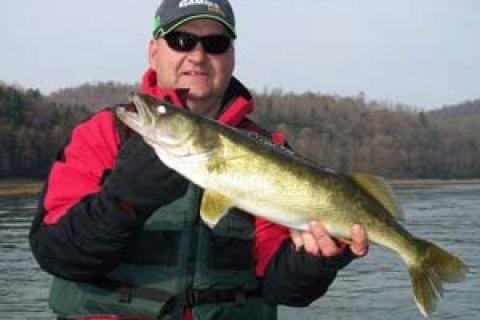
Throughout much of the walleyes' home range, river systems provide a significant though somewhat polarized angling resource. Due to shifts in location driven by propagation needs, forage considerations, and current level and water temperature changes, consistently catching "here today, gone tomorrow" river walleyes is a challenge.
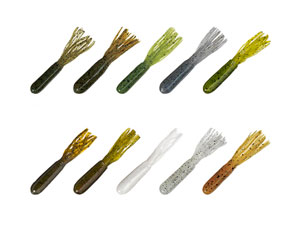 |
| Thin bodied tubes are great drifting bait. |
While it is said that "rivers are rivers," physical differences exist that have a sizeable effect on the species as well as those that pursue it. Some rivers are free-flowing, while others impounded by locks and dams. A river's widening into a lake or reservoir gives walleyes a host of additional options, as do off-channel backwaters. Climb aboard as we take a walleye-fishing cruise through the many transitions river fish experience.
After the Ice Melts
I spend much of my time fishing and guiding on the free-flowing portion of western Pennsylvania's Allegheny River. Pennsylvania has a closed walleye season during the spawn, starting in mid-March. Typically one can squeeze in a week or two of fishing between the time the ice flushes from the river and the start of the six- to seven-week closure.
With water temperatures in the high 30s and low 40s, I find walleyes stacked up in the same deep, slow wintering holes where they were when things froze up the prior winter. Whereas impounded rivers offer obvious barriers that limit walleyes' upriver movement, on free-flowing river sections 'eyes will be found in slower slackwater zones. Often deep pools will be formed on the outsides of river bends, though the slower current areas are usually on the inside portions of these pools. Providing there is sufficient depth located below them (8 to 12 feet or more), mid-river islands often form attractive current breaks. Small to mid-sized streams usually have a sand/gravel bar at their mouths and material deposited into the creek mouth during high water events. These macro-sized natural wingdams often have suitable walleye habitat below them; in some situations slow pools are formed upriver as well.
Catching these walleyes, which have yet to move into spawning areas, usually requires a two-method approach. Throughout the day, when fish are scattered and in a neutral feeding mood, odds favor slip-drifting throughout the pool, paying close attention to subtle bottom drop-offs, which can hold a pocket of fish. A thin-bodied tube — such as Case Plastics' 3.75 Salty Tube — is great drifting bait when teamed with a quarter- or three-sixteenth ounce insert style jighead. These areas often provide a good witching hour bite, as feeding walleyes slide up onto shallow gravel bars to feed. Hair/feather jigs like Jimmy D's Riverbug excel when pitched onto rock/sand/gravel shallows from an anchored boat.
Springtime
Spring finds walleye aces such as Bruce "Doc" Sampson hitting major rivers such as the Mississippi and Missouri right about the time the fish begin moving into spawning areas.
"On impounded rivers, walleyes make a major upriver movement toward dams during the late fall," notes the Minnetrista, Minn., veteran. "Many, though not all, will spawn in close proximity to the dams."
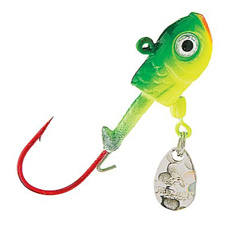 |
| The Northland Thumper can be used in slower, clear water, flowing with the current. |
In Samson's experience, which includes fishing river systems of varying sizes and physical complexities, the habitat walleyes use for spawning can greatly differ. He says walleyes on the Mississippi often spawn in flooded areas rich in weeds and wood. On the Missouri, such as the area near Chamberlin, S.D., shoreline rip rap offers up the best spawning habitat.
Particularly during the daytime, male walleyes comprise much of the catch during the spawning period. The night bite produces most of the larger females, says Samson.
"Just like in a lake, the males hang around the spawning area, while the females quickly disperse," he notes. "It's really tough to catch those bigger females for about two weeks after the spawn."
The two-week layoff is just a general guide, says Samson, since the actual spawn has variables that make determining its timing and duration a bit cloudy. But the time following this recuperative sabbatical is one of the best for pinning bigger river walleyes.
In following dispersing post-spawn walleyes Samson often keys in on deeper water, such as the first lip coming off the shoreline, where the break drops into 10 to 12 feet. Using his cable-drive Minn Kota Fortrex to stay on the edge — and the subtle walleye-holding current breaks the structure provides — he flows with the current, presenting a Northland Fireball jig in slower water and a Northland Thumper jig in clear water. He uses both live bait and soft plastic tipping options, based on the mood of the fish.
"The Thumper has a blade, which you would think would fare better in stained water," he notes. "But it's been more productive for me in clear water conditions."
Summer
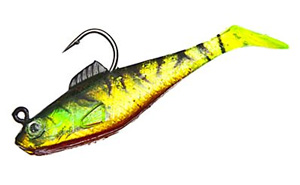 |
| Pre-rigged soft swimbaits work well when cast cross current. |
As spring gives way to summer, walleyes scatter throughout a river system. Finding warm water river walleyes can often be a challenge. While fast current pushes walleyes into identifiable slow-current areas when the water is cold, the case is different now.
By late spring and early summer, walleyes on free-flowing rivers — barring higher-than-normal flows — will be in and around higher current areas. Such rivers offer a combination of riffles, runs and pools. When water temperatures get into the 60s and higher, expect to find 'eyes in moving water and responding to moving baits.
Lengthy riffles can contain mild white-water as the gradient-dropping flow deflects over shallow rocks and then spill into runs — those moderate current areas often seasoned with submerged rocks and boulders. In normal to low flow conditions, walleyes — feeding ones in particular — will nose right up into base of the riffle area, using the slack side of rocks as a current break and ambush point.
Pre-rigged soft swimbaits like Northland's Slurpies Shad and Storm's Wildeye Curl Tail Minnow do well when cast cross current as the boat drifts through such slots. Maintain just enough speed to keep the bait from hanging up on the rocks. And don't be surprised if a walleye hits at boatside. River walleyes show a strong inclination to follow, particularly in clear water — a trait likely driven by their finicky nature.
Less active fish can be found in the run areas, which vary in depth from about 4 to 9 feet. While not as aggressive as their fast-water feeding kin, these fish can still be caught. Salt-laden sinking worms like Case's Magic Stik can be dead-sticked as the boat drifts through the run area. The bait will tantalizingly suspend above the cover. Maintain enough line tension to feel the pickup.
River Tips
In stained and cloudy water, it's productive to show free-flowing river walleyes bigger/noisier baits. The summer of 2009 furnished enough rain and thunderstorm activity, in my world anyway, to keep rivers unusually stained. Two of the better walleye presentations were rattlebaits like XCalibur's Xr50 and sizeable spinnerbaits such as Booyah's Double Willow Blade and Mini Shad models, which do a nice job of mimicking river shiners. White and chartreuse skirts, not surprisingly, were most effective.
Walleye location becomes more complicated on larger rivers, such as the Mississippi's Pool 4, which drains into Lake Pepin, and also has an extensive backwaters channel. These walleyes have a list of spots.
 |
| Rattlebaits are effective in stained or cloudy river water. |
"Even on Pool 4 there's still a resident population of walleyes that stay in the main river during the summer," says Claremont, Minn., walleye pro Brett King.
King says current is the primary draw for main river walleyes when water temperatures rise. He expects to find harder current on outside river bends, where the flow pushes up against the bank. Necked down areas, where the river pinches in, also elevates the flow.
"Channel edges will hold fish, particularly when the bottom features a series of sand dunes," explains King. "Clam beds are another walleye magnet during the summer. They provide a hard-bottomed area, and river walleyes love hard bottom."
King uses a run and gun approach to cover keys areas. Armed with a 7-foot, moderately-tipped spinning rod, he pulls up on a potential area, pitches out a cast and begins a troll. For summertime river trolling, he leaves the line-counter level winds and rod holders at home.
"I reel in enough to where the bait is tapping the bottom just the way I want it," he says. "When you are fishing those sand dunes, you really want to dig in the bottom, to stir things up."
Both upstream and downstream trolls can be productive, says King. Boat speed can be reduced on an upriver troll, since the pull of the current helps work the lure. And the boat can be allowed to slide from side to side in an efficient manner. The downriver troll quickly puts the bait right in their faces, often triggering a reaction bite.
"You need to try both directions to figure out which is best that particular day," adds King.
King likes to hand-hold the rod during summer outing. Reels are spooled with Fireline. His favorite bait is a Lindy Shadling.
When rivers flow low during the summer, long-time Hager City, Wisc., pro Scott Fairbairn keys in on wingdams because they too can funnel current.
"There may be a hundred wingdams on a pool of the river, but only three or four will have current and be productive," he notes.
Boil lines indicate the presence of walleye-attracting current. Whereas anchoring is the commonly accepted boat control method for working wingdam faces, Fairbairn often finds it most productive — when the flow is low — to hold the boat with the trolling motor, casting a quickly diving crankbait like Rapala's DT Flat to pick off active fish. He positions the boat upriver of the structure, just to the inside of its tip.
Fall
The transition from summer to fall is a welcome one for many river anglers, as the fish begin a movement to predictable cold water locations, one triggered by both higher flows and cooler water.
"Usually around early to mid fall we'll experience rain that begins to elevate the flow," says Fairbairn. "It's a natural response for walleyes to move upriver when the flows increase. Now walleyes that were scattered over a variety of areas begin to move to more classic locations."
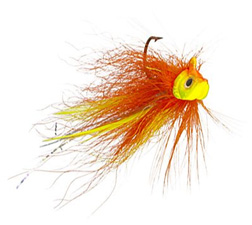 |
| In mid- to late fall, try a hair jig pitched to the shoreline to pick off fish holding along quick-dropping banks. |
Fall rains appear most years but not always. But the other driving force is water temperature, and it will cool off, rain or no rain. This, in Fairbairn's experience, is the more significant fall factor.
"Like many river systems, the Mississippi River's forage base is driven by shad," he says. "When the water drops below 60, shad will move to seek warmer water. Backchannel areas are the first to cool. So the cooler water draws them out of these hard-to-fish areas, along with the walleyes that were there feeding on them."
Fairbairn says that when you get the combination of cooling water and higher flows, it's like throwing the "on" switch.
"Classic barrier areas like dam tailraces and creek mouths, places that were a dead zone, suddenly turn on," he notes. "And now you've got the fish cornered."
Once in these areas, walleyes tend to stay there from fall through the winter. Tailrace areas typically have current seams that congregate fish, flow edges formed by the discharges from dam gates and hydroelectric power plants. Flows change often, depending on rain, power production and in-service gates. So though there are concentrations of fish there, the day-to-day challenge of finding them under fluctuating conditions remains.
Susquehanna River guide Dave Neuman too finds a connection between gizzard shad and fall walleye location. As water temperatures drop toward 50 degrees, shad move downriver toward impounded sections (where the water is warmer). A percentage of them are pulled through the dam's power turbines to the eagerly waiting walleyes below. It's a window that typically last three to four weeks.
During early fall, on free-flowing rivers I find walleyes in tailout areas of long pools, areas right above the riffles. They hide in tuffs of eelgrass, picking off soft jerkbaits like Case's Sinkin' Salty Shad twitched above them. By mid to late fall, they've moved into long, deeper pools with light current. Hair jigs and tube jigs pitched to the shoreline pick off fish holding along quick-dropping banks as the boat drifts along. And by the time the water drops into the upper 30s, they seek shelter in the protected slackwater spots where they will winter, providing consistent fishing until the water turns hard. And if the higher power is willing, that's where they'll still be when the surface melts in a couple long, cold months.
- 8455 views

